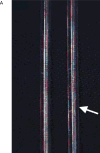Integration of indocyanine green videoangiography with operative microscope: augmented reality for interactive assessment of vascular structures and blood flow
- PMID: 25710107
- PMCID: PMC5399681
- DOI: 10.1227/NEU.0000000000000681
Integration of indocyanine green videoangiography with operative microscope: augmented reality for interactive assessment of vascular structures and blood flow
Abstract
Background: Preservation of adequate blood flow and exclusion of flow from lesions are key concepts of vascular neurosurgery. Indocyanine green (ICG) fluorescence videoangiography is now widely used for the intraoperative assessment of vessel patency.
Objective: Here, we present a proof-of-concept investigation of fluorescence angiography with augmented microscopy enhancement: real-time overlay of fluorescence videoangiography within the white light field of view of conventional operative microscopy.
Methods: The femoral artery was exposed in 7 anesthetized rats. The dissection microscope was augmented to integrate real-time electronically processed near-infrared filtered images with conventional white light images seen through the standard oculars. This was accomplished by using an integrated organic light-emitting diode display to yield superimposition of white light and processed near-infrared images. ICG solution was injected into the jugular vein, and fluorescent femoral artery flow was observed.
Results: Fluorescence angiography with augmented microscopy enhancement was able to detect ICG fluorescence in a small artery of interest. Fluorescence appeared as a bright-green signal in the ocular overlaid with the anatomic image and limited to the anatomic borders of the femoral artery and its branches. Surrounding anatomic structures were clearly visualized. Observation of ICG within the vessel lumens permitted visualization of the blood flow. Recorded video loops could be reviewed in an offline mode for more detailed assessment of the vasculature.
Conclusion: The overlay of fluorescence videoangiography within the field of view of the white light operative microscope allows real-time assessment of the blood flow within vessels during simultaneous surgical manipulation. This technique could improve intraoperative decision making during complex neurovascular procedures.
Figures











References
-
- Karhunen PJ. Neurosurgical vascular complications associated with aneurysm clips evaluated by postmortem angiography. Forensic Sci Int. 1991 Oct;51(1):13–22. - PubMed
-
- Siasios I, Kapsalaki EZ, Fountas KN. The role of intraoperative micro-Doppler ultrasound in verifying proper clip placement in intracranial aneurysm surgery. Neuroradiology. 2012 Oct;54(10):1109–1118. - PubMed
-
- Alexander TD, Macdonald RL, Weir B, Kowalczuk A. Intraoperative angiography in cerebral aneurysm surgery: a prospective study of 100 craniotomies. Neurosurgery. 1996 Jul;39(1):10–17. discussion 17–18. - PubMed
-
- Amin-Hanjani S, Meglio G, Gatto R, Bauer A, Charbel FT. The utility of intraoperative blood flow measurement during aneurysm surgery using an ultrasonic perivascular flow probe. Neurosurgery. 2008 Jun;62(6 Suppl 3):1346–1353. - PubMed
-
- Raabe A, Beck J, Gerlach R, Zimmermann M, Seifert V. Near-infrared indocyanine green video angiography: a new method for intraoperative assessment of vascular flow. Neurosurgery. 2003 Jan;52(1):132–139. discussion 139. - PubMed
Publication types
MeSH terms
Substances
Grants and funding
LinkOut - more resources
Full Text Sources
Other Literature Sources

